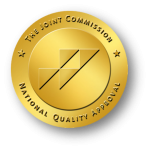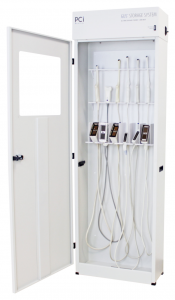Ultrasound Cabinets: Compliance Guidelines


In recent years, proper storage of ultrasound probes has fallen under the increased scrutiny of compliance surveyors. The Joint Commission (TJC) has defined guidelines on storage for semi-critical devices:
<"The endoscope should be hung vertically, with the distal tip hanging freely in a well-ventilated, clean area, following the endoscope manufacturer's written IFU for storage...Store endoscopes in a manner that will protect them from damage or contamination."
Probe Storage Time
How long can you store a disinfected probe before you need to reprocess it again?
Currently, there aren't any recommendations or standards regarding the 'hang time' of a disinfected probe. If probes are turned around frequently in a high-volume facility, then storage time may not be an issue.
One could point to the best practices of scope storage as a frame of reference. Safe storage of endoscopes has been monitored closely for a while. Like ultrasound probes, endoscopes are classified as semi-critical devices which require high-level disinfection.
Organizations such as AORN (Association of periOperative Registered Nurses) and SGNA (Society of Gastroenterology Nurses and Associates) previously issued storage interval times recommendations, with AORN advising that endoscopes should be high-level disinfected if not used for more than five days, while SGNA recommended seven days.
BEST PRACTICE:
While there may not be a specific recommendation on storage time for ultrasound probes, the best practice is to develop an internal policy. Such a policy provides consistency in your infection control processes and is something tangible you can point to if asked by a surveyor.
Plastic Covers
Plastic covers for ultrasound probe storage can be problematic for two key reasons:
- If the probe is not completely dry, it creates an environment conducive to microbial growth.
- The aforementioned TJC standard states: "Store the device in a manner that will protect from damage or contamination..." Plastic covers do not protect the probes from damage such as bumps, cable tangles, falls, etc. The distal tip of a probe is very fragile!
GE also states: "Do not use cloth or plastic bags to transport transducers. This will result in damage to the transducer."
Probe Manufacturers
Probe manufacturers have issued recommendations on probe storage for some time now. The following are some best storage practices according to Philips:
- Avoid storing transducers in areas of temperature extremes or in direct sunlight.
- Store transducers separately from other instruments to avoid inadvertent transducer damage.
- Before storing transducers, make sure they are thoroughly dry.
- For TEE transducers, be sure the distal tip is straight and protected before storing the transducer
- Never store a TEE transducer in the carrying case, except to transport it.*
BEST PRACTICE
*Never use the original transducer carrying case to transport or store a non-disinfected probe. The foam packaging could become contaminated and the case might be accidentally re-used with a disinfected probe.
Storage Air Cabinet Flow
 The constant flow of filtered air in a cabinet aids in the drying process and creates positive pressure inside the cabinet, helping to prevent aerobic bacteria from re-contaminating probes.
The constant flow of filtered air in a cabinet aids in the drying process and creates positive pressure inside the cabinet, helping to prevent aerobic bacteria from re-contaminating probes.
CIVCO's Ultrasound TEE Probe Storage Cabinet includes a quiet, energy-efficient fan that draws air through a HEPA filter, trapping particles as small as 0.3 microns. As a frame of reference, a human hair is 100 microns.
In our recent Pub Brief, we broke down a study that examined the effectiveness of longer clean storage hanging times (the time frame in which a medical device can be stored in a contained, controlled environment that limits damage and exposure to moisture, while also protecting the device from harmful pathogens) in reducing the presence of microorganisms on transesophageal (TEE) probes. Over the course of their research, the authors processed a total of 140 bacteria samples that were collected from TEE probes that had been stored in CIVCO's TEE Ultrasound Probe Storage Cabinet for 30 days. Ultimately, the results of the study showed zero pathogenic bacterium on any of the tested probes, leading the authors to conclude that a 30-day hanging time for TEE probes post-HLD in a positive pressure HEPA-filtered cabinet is an acceptable amount of time to reduce the risk of pathogenic bacteria growth.
HEPA filters - Not all filters are created equally.
HEPA is an acronym for "High-Efficiency Particulate Air" or "High-Efficiency Particulate Arrestance." A HEPA filter is a high-quality micro-filter. Note that a filter described as 'HEPA media' is not the same high quality as a 'true HEPA' filter.
Also, when looking at the cabinet's filters, take note of how often you need to change the filter and whether tools are required for the change. Given the height of the cabinet, it may be cumbersome to change out the filters depending on the cabinet's design.
Probe Design & Infection Control
The design of an ultrasound probe is such that only the transducer is high-level disinfected. The electrical connector holder is not watertight and depending on the manufacturer and age of the probe, the strain relief (directly above the probe's handle) may also not be watertight. This design presents a storage challenge when trying to keep the disinfected probe separate from the cables and electrical connector, which are only low-level disinfected.
This design issue can be particularly challenging with transesophageal (TEE probes) that have long insertion tubes similar to endoscopes. Unlike probes, however, endoscopes undergo full high-level disinfection.
BEST PRACTICE
Given the said challenge presented by an ultrasound probe's design, it's critical that the disinfected probe does not come in contact with the probe cable or electrical holder during storage. Look for cabinets that offer specialty dividers that ensure that cables and holders do not touch the disinfected probe.
Learn more about probe storage guidelines on our In-the-Know Blog





